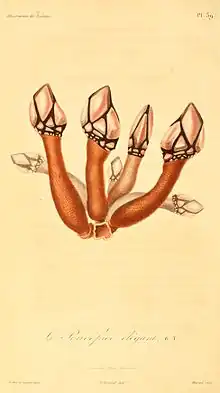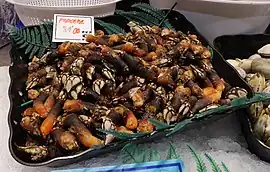| Pollicipes elegans | |
|---|---|
 | |
| Original drawing of Pollicipes elegans illustrated by René Lesson in 1831 | |
| Scientific classification | |
| Domain: | Eukaryota |
| Kingdom: | Animalia |
| Phylum: | Arthropoda |
| Class: | Thecostraca |
| Subclass: | Cirripedia |
| Order: | Pollicipedomorpha |
| Family: | Pollicipedidae |
| Genus: | Pollicipes |
| Species: | P. elegans |
| Binomial name | |
| Pollicipes elegans (Rene Lesson, 1831)[1] | |
| Synonyms | |
|
Pollicipes rigidus Sowerby, 1839 | |
Pollicipes elegans, the Pacific goose barnacle, is a species of gooseneck barnacle inhabiting the tropical coastline of the eastern Pacific Ocean.[2] Its habitat borders a close relative, Pollicipes polymerus, a gooseneck barnacle covering the coastline of the Pacific Northwest. Other species belonging to the genus Pollicipes are found along the eastern coastlines of the Atlantic Ocean.
Description
Pollicipes elegans is a stalked marine organism characterized by having a plated capitulum shaped similar to a goose head. The capitulum consists of two hinged shells which will open for feeding and are held up by a scaled peduncle attached to substrate.[3] Both the capitulum and stalk are red-orange.[4] This coloring is shared with P. polymerus but in contrast to the eastern Atlantic species, Pollicipes pollicipes, which is consistent with gray and white based coloring. The scales of P. elegans are also long and narrow.[3]
Habitat and distribution
Covering the eastern tropical zone of the Pacific Ocean, Pollicipes elegans is found scattered across rocky intertidal zones. Habitats across the genus Pollicipes are generally similar, with clustered mounds of goose barnacles poking out from different substrates. These clusters are often attached to inverted rocks hanging above a tidal pool. The inversion allows the shell opening to protrude the water's surface below.[5]

The species can be found along the Pacific coastlines of northern Mexico all the way down to the northern tip of Chile. However, there are stretches of coastline along Central America where increased atmosphere and water temperatures have prevented dispersal of P. elegans populations.[6] Historical limitations similar to this, such as extreme cold or extreme hot climates, are what separated the original tropical population.[7] Despite high temperatures, there are still strong populations in Costa Rica[5] and El Salvador.[6] The species is also known for overlapping habitats of P. polymerus throughout southern regions of California.[5]
Though barnacle-type organisms are typically found on the hulls of ships or floating decks, P. elegans does not commonly exhibit this behavior.[8]
Life history
There are four total species in the genus Pollicipes spread about the eastern coastlines of the Pacific and Atlantic Oceans. The closest extinct relative, Pollicipes aboriginalis, resided in western regions of Australia, inhabiting an eastern coastline of the Indian Ocean.[9] Beyond that is a Tethyan relict whose distribution bordered the current genus's fossil records. The current population of goose barnacles was once a much larger and sound population of sea fauna from the Tethys Ocean, with Pollicipes polymerus branching off from the population before new species emerged. P. elegans, P. pollicipes, and P. caboverdensis are more closely related to one another than they are to P. polymerus.[9]
Reproduction

Similar to its relatives, P. elegans is a hermaphroditic[8][10] organism. In spite of this and because of the colonies' high density, the species also experiences high polyandry with some spawn groups having up to five participating males. The purpose is to either make up for a smaller population or to ensure the fertilization of future offspring.[10]
Spanish delicacy
Historically, California's indigenous people were known to cook and consume the peduncle of Mitella polymerus, which is now known as Pollicipes polymerus.[11] Though the Pacific goose barnacle itself is known for being edible,[9] it is not commonly served today in North, Central, or South America. The entire organism cannot be consumed whole because of the hard shell of the capitulum and the leathery skin of the stalk, both must be removed completely for consumption. In Galicia, P. pollicipes is known as percebes, a delicacy boiled and served whole on a dish.[12]
References
- ↑ "WoRMS - World Register of Marine Species - Pollicipes elegans (Lesson, 1831)". www.marinespecies.org. Retrieved 2023-03-23.
- ↑ Oceanography and marine biology : an annual review. Volume 60. S. J. Hawkins. Boca Raton. 2022. ISBN 978-1-003-28860-2. OCLC 1353293212.
{{cite book}}: CS1 maint: location missing publisher (link) CS1 maint: others (link) - 1 2 "Robert H. MORRIS, Donald P. ABBOTT & Eugene C. HADERLIE, 1980. Intertidal Invertebrates of California: xi + 690 pp., 6 maps, 200 coloured plates. Stanford University Press, Stanford, California, U.S.A. ISBN 0-8047-1045-7. Price $U.S. 30.00". Crustaceana. 41 (3): 319. 1981. doi:10.1163/156854081X00930. ISSN 0011-216X.
- ↑ FERNANDES, JOANA N.; CRUZ, TERESA; VAN SYOC, ROBERT (2010-08-03). "Pollicipes caboverdensis sp. nov. (Crustacea: Cirripedia: Scalpelliformes), an intertidal barnacle from the Cape Verde Islands". Zootaxa. 2557 (1): 29. doi:10.11646/zootaxa.2557.1.3. ISSN 1175-5334.
- 1 2 3 Mora-Barboza, Cristian; Sibaja-Cordero, Jeffrey A. (October 2018). "Occurrence, Demography, and Habitat Features of Pollicipes elegans (Pollicipedidae: Scalpelliformes), an Amphitropical Species at a Rocky Intertidal Shore, Costa Rica". Pacific Science. 72 (4): 449–461. doi:10.2984/72.4.5. ISSN 0030-8870. S2CID 91513734.
- 1 2 Walther, Kathleen; Crickenberger, Samuel E.; Marchant, Sergio; Marko, Peter B.; Moran, Amy L. (May 2013). "Thermal tolerance of larvae of Pollicipes elegans, a marine species with an antitropical distribution". Marine Biology. 160 (10): 2723–2732. doi:10.1007/s00227-013-2265-x. ISSN 0025-3162. S2CID 253745003.
- ↑ Marchant, Sergio; Moran, Amy L.; Marko, Peter B. (December 2015). "Out-of-the tropics or trans-tropical dispersal? The origins of the disjunct distribution of the gooseneck barnacle Pollicipes elegans". Frontiers in Zoology. 12 (1): 39. doi:10.1186/s12983-015-0131-z. ISSN 1742-9994. PMC 4696079. PMID 26719753.
- 1 2 Darwin, Charles (1851). A monograph on the sub-class Cirripedia, with figures of all the species. MBLWHOI Library. London, Ray society.
- 1 2 3 Van Syoc, R. J.; Fernandes, J. N.; Carrison, D. A.; Grosberg, R. K. (2010-08-31). "Molecular phylogenetics and biogeography of Pollicipes (Crustacea: Cirripedia), a Tethyan relict". Journal of Experimental Marine Biology and Ecology. The Biology of Barnacles' in honour of Margaret Barnes. 392 (1): 193–199. doi:10.1016/j.jembe.2010.04.024. ISSN 0022-0981.
- 1 2 Plough, Louis V.; Moran, Amy; Marko, Peter (2014-04-16). "Density drives polyandry and relatedness influences paternal success in the Pacific gooseneck barnacle, Pollicipes elegans". BMC Evolutionary Biology. 14 (1): 81. doi:10.1186/1471-2148-14-81. ISSN 1471-2148. PMC 4021092. PMID 24739102.
- ↑ Aschmann, Homer (July 1981). "The natural world of the California Indians". Journal of Historical Geography. 7 (3): 319–321. doi:10.1016/0305-7488(81)90020-7. ISSN 0305-7488.
- ↑ SunnySideCircus (2020-01-27). "Percebes: The Most Expensive Seafood In The World!". SunnySideCircus. Retrieved 2023-04-18.